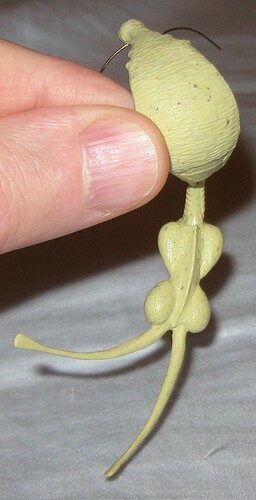The gargarimthis is starting to look like, well, a gargarimthis.
In my experience, almost everyone assumes every alien creature will be some kind of monster. I take a very different view. As living beings, every alien is part of a biosphere and struggles for survival within that environment. The creature eats something. Something eats the creature. No alien creature evolved just to chase young human women and eat space marine faces.
At some point, I decided the gargarimthis is very similar to a Terran herbivore. On Earth, herbivores eat plants. An alien world will not have animals or plants. Those organisms evolved on Earth. However, an alien world may have living beings that harness sunlight for energy in a way very similar to plants, and motile creatures that eat those sun harnessing entities in a way much like animals. The gargarimthis is such a creature.
Why does the gargarimthis have that gigantic hood? After some thought, I decided it serves three purposes.
Unlike the hood of a cobra, the hood of a gargarimthis is always extended so it must perform a vital function. Since it is so large and thin it acts as a heat exchange. Elephant ears and, according to some scientists, dimetrodon sails serve the same purpose.
The hood is also a display structure. A gargarimthis breeds using some form of sexual reproduction and is sexually dimorphic. Psedo-male and pseudo-female gararimthi consider hood pattern and size when selecting a suitable mate.
Finally, something very large and nasty likes to hunt gargarimthi. It probably hunts young human women and attacks space marines, too. One way to scare off predators is to be very large. A gargarimthis appears much larger than he of she actually is because of the hood, which detours at least some predators.
A gargarimthis has one very large central eye, on a stalk that can swivel, and 4 smaller eyes along the edges of the hood. This gives the creature good all around vision but poor stereoscopic sight. No terrestrial animal uses such an arrangement but some trilobites worked in a very similar way.
A gargarimthis also has a very long, segmented neck and a fairly deep chest. The creature probably works like a small giraffe.
Much like gazelles, gargarimthi are runners. The bulk of the creature is tightly formed around the center of gravity. The rear leg muscles and twin tails of the creature need to counter balance the large but delicate head. As a result, the body is starting to look very cat like. The final shape will strongly depend on how the legs and leg muscles attach to one another.
The skin of the creature appears very leathery. This is very probably an adaptation to detour parasites. Scales, hair, and feathers are extremely specific and unlikely adaptations used by terrestrial animals so I do not want to copy them.
The gargarimthis still has some fun traits to reveal but those must wait for more sculpting and another day. ![]()

